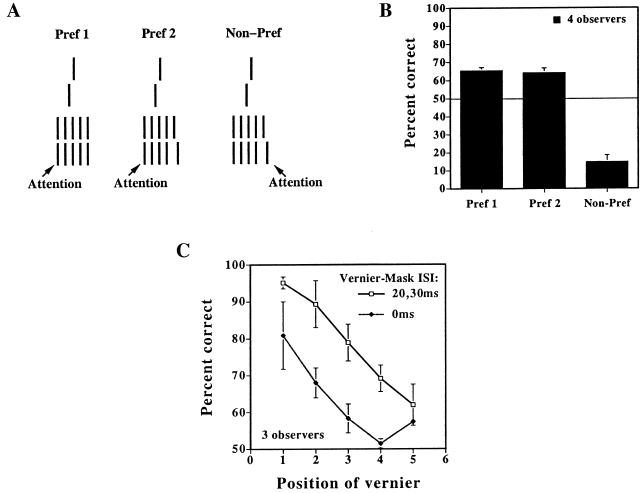Figure 2.
Features are mislocalized and “travel” into the focus of attention. (A) Most subjects claim to focus on one of the two outside edges of the grating to judge the direction of induced offset (preferred edge). To test this statement, we displayed a vernier followed by a grating in three conditions. In the first condition (Pref 1), the vernier is followed by a grating having only straight elements. Subjects attend to their preferred edge. In the second condition (Pref 2), the grating comprises four elements without offset plus an additional double-bar carrying an offset with offset direction opposite to the vernier. This element is located opposite the subject's preferred edge. Observers attend to their preferred edge. In the third condition (Non-Pref) the same stimuli were used as in the condition before (that is, outer element offset in opposite direction than vernier). However, subjects were instructed to switch attention to their nonpreferred edge. (B) Focusing on the preferred location hardly changes the amount of correct responses determined according to the foregoing vernier independent of whether (Pref 1) or not (Pref 2) the grating comprised an element with a real offset. However, focusing on the opposite location, where the offset element is displayed, leads to a very significant reduction of correct responses. This indicates that the offset element of the grating determines decision (Non-Pref). (C) To investigate feature inheritance in a more quantitative fashion, the vernier was presented at the five positions of the grating having five straight elements. Position 1 indicates the preferred location, position 5 the opposite location. Percentage of correct responses drops monotonically and almost linearly from its maximum if the vernier is presented close to the preferred, attended edge to almost chance level at the nonpreferred edge of the grating. C also shows the dependence of performance on interstimulus (ISI) time between vernier and grating (for two observers, 30 ms; for the other one, 20 ms).

